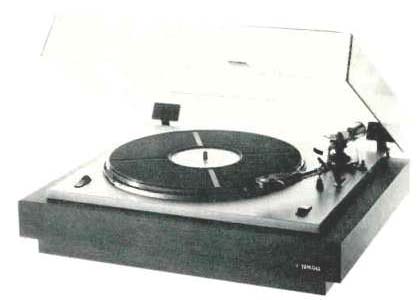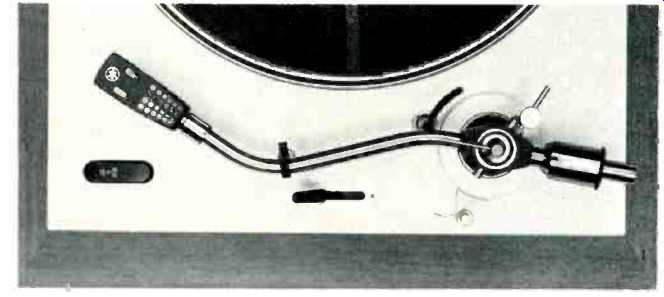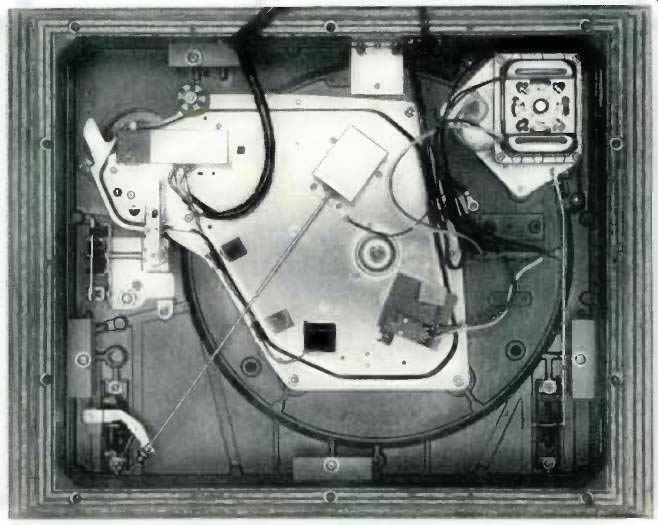
MANUFACTURER'S SPECIFICATIONS:
Motor: Synchronous outer-rotor type.
Speeds: 33 1/3 and 45 rpm.
Automatic pick-up and return.
Wow and Flutter: less than 0.05%. S/N Ratio: 50 dB.
Platter: Diecast aluminum, 12 in. diameter.
Tonearm: Static-balanced "S"-type, gravity center mechanism.
Stylus Force: 0 to 4 gms.
Shell: Universal plug-in type; weight, 12 gms.
Cartridge Weight Range: 5 to 15 gms.
General Specifications:
Power Source: Switchable 100,110, 117, 125, 200, 240 V., 50/60 Hz.
Power Consumption: 15 W.
Dimensions: 19 in. W. x 16 1/4 in. D. x 6 1/4 in. H.
Weight: 20 lbs.
Price: $220.00.

Fig. 1 -- Top view of turntable.

Fig. 2 -- Internal view of turntable.
It was bound to happen some day. Some company would bring out an automatic turntable that was belt driven--and it finally has. The Yamaha YP-701 has no idler, no stepped pulley on the motor which contacts an idler wheel which in turn contacts the inside rim of the platter to provide the driving power. Instead, the platter is driven by a belt around its rim and around a two-step motor shaft for 33 1/3 and 45 rpm, in just the same manner as is often found in professional turntables of the highest quality. (Belt-driven automatic turntables are also being marketed by British Industries Corporation. -Editor)
The automatic part of the mechanism is engaged only during the shut-off cycle, and therefore contributes no drag to the platter while it is actually playing the record, which is as it should be. At the conclusion of playing the mechanism is tripped, engaging a nylon gear on the turntable shaft which drives a large gear which goes through the usual cycle to lift the arm and return it to the rest, then shuts off the motor.
The chassis, finished in satin silver, is mounted on a solid plywood base, rubber insulated and damped. The platter is die cast, and fitted with a neatly textured mat. At the left front corner is a toggle which changes speed by shifting the belt from one diameter of the motor shaft to the other, and at the right front corner is another toggle which turns on the motor switch, or initiates a cycle which causes the arm to lift and return to its rest, and then stops the motor.
The arm balancing weight is an unusual feature. Once the actual zero-balance point has been determined, the forward portion of the weight, which turns separately from the rear portion, is set to indicate "O" and then the entire weight is rotated to set the desired stylus force, with the graduations on the front portion of the weight then serving to indicate the actual stylus force, in grams. The arm is shaped in a gentle "S" curve to provide the horizontal balancing which in other turntables is often provided by a separate weight extending laterally from the arm, thus contributing possible confusion as to where it should actually be set for optimum performance.
Anti-skate compensation is provided by a small weight which hangs from a thread over an integral formed-wire support. The cueing lever has a comfortably-sized handle forward of the arm support, and the arm rest has a wire locking device to hold the arm firmly while moving the entire turntable. The perforated light-weight cartridge head is held onto the arm by a bayonet-type locking ring.
Underneath, the chassis is a model of neatness. Of special importance is the well-shielded termination for the external leads which are already prepared for use with CD-4 cartridges, having the low capacitance of 93 pF, in contrast to usual capacitance of the order of 300 pF in turntables not especially set up for CD-4 cartridges.
On the rear of the base is an etched plate indicating the proper orientation of a multi-pin plug which may be inserted for various voltages encountered throughout the world--100, 110, 117, 125, 220, and 240. A small lever accessible under the platter permits adjustment for frequency--50 or 60 Hz, thus making the unit usable practically everywhere, since 25-Hz line supply is rarely, if at all, encountered anymore.
Performance
Using the CBS BTR-150 test record, wow and flutter was measured at 0.06 %. Separately, wow alone measured 0.05 %, and flutter 9.04%, both of which are excellent. Rumble was measured at -55 dB (NAB weighted) below 3.54 cm/sec at 1000 Hz, also a good figure, even with a high quality turntable.
Since the motor is hysteresis synchronous, its speed was not affected by large variations in voltage, and speed was maintained with the line voltage dropped as low as 30 volts, although reliable operation and the arm-returning cycle required at least 65 volts, much lower than any domestic supply is likely to run.
Operation and handling of this unit was extremely smooth, and while it is not inexpensive, its performance rates high. In order to maintain its high performance, the maintenance kit provided contains an oil dispenser, two screwdrivers, tweezers, two stylus brushes of different types a record cleaner (the usual "cleaning" cloth), and a tube of grease--all in addition to the 45-rpm adapter. With these, the user should be able to maintain the unit's original performance for years.
--C. G. McProud
(Source: Audio magazine, Jun. 1975)
Also see:
Yamaha P-850 Turntable (Sept. 1982)
Wheaton Tri-Planar II Tonearm (Jun. 1988)
Visonik Model DD-8200 Turntable (May 1979)
C/M Laboratories Receiver RR805 (June 1975)
= = = =